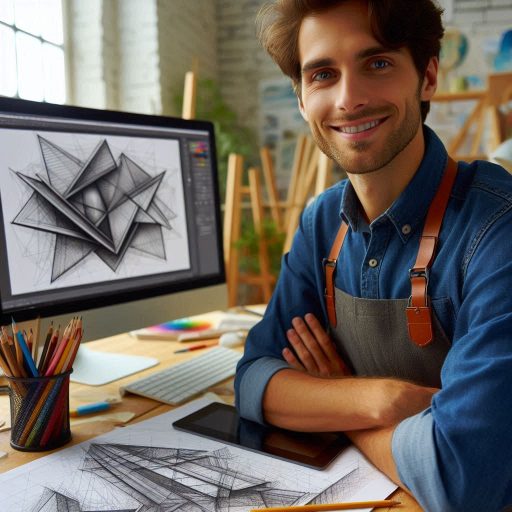Introduction
Digital art has transformed the landscape of modern design.
With its blend of creativity and technology, it plays a pivotal role in shaping visual culture.
This post explores the significance of digital art in contemporary design and its revolutionary impact on the industry.
Digital art refers to artistic works created or enhanced using digital technology.
Artists use software tools and digital devices to produce visuals that were once impossible with traditional media.
This medium includes graphic design, digital painting, 3D modeling, and animation.
Its importance lies in its versatility and accessibility.
Digital art allows designers to experiment with different styles and techniques efficiently.
It facilitates rapid prototyping and iteration, crucial for meeting tight deadlines.
Additionally, digital art broadens the scope of creativity by integrating multimedia elements.
This approach not only streamlines the design process but also enhances the final output’s quality and impact.
Digital art has revolutionized the design industry in several ways.
First, it has democratized access to art creation tools.
Previously, high-quality design required expensive materials and specialized training.
Now, anyone with a computer and software can create professional-level artwork.
Second, digital art has introduced new techniques and styles.
The ability to manipulate and layer digital elements allows for innovative designs that challenge traditional boundaries.
Third, digital art has transformed workflows.
Designers can collaborate remotely, share files instantly, and make real-time updates, which accelerates project completion.
Finally, digital art has expanded the possibilities for design applications.
Transform Your Career Today
Unlock a personalized career strategy that drives real results. Get tailored advice and a roadmap designed just for you.
Start NowFrom virtual reality to interactive media, digital art enhances user experiences in ways that were previously unimaginable.
In fact, digital art is a cornerstone of modern design. It revolutionizes the industry by making art creation more accessible, introducing novel techniques, transforming workflows, and expanding design applications.
Embracing digital art is essential for staying relevant and competitive in today’s design landscape.
History of Digital Art
The origins of digital art and how it has evolved over time
Digital art began in the 1950s with early experiments in computer graphics.
Artists used computers to create abstract designs and manipulated images through algorithms.
These pioneering efforts laid the groundwork for what would become a dynamic field.
In the 1960s, artists like Frieder Nake and Harold Cohen began using computer programs to generate artwork.
Nake created algorithms that produced intricate patterns, while Cohen developed AARON, an AI-based art-generating system.
These innovations expanded the possibilities of what could be considered art.
Key technological advancements that have shaped digital art
The 1970s saw further technological advancements with the advent of digital image processing.
Artists could now manipulate and alter images with precision.
This era marked the transition from abstract digital art to more complex and realistic forms.
The development of personal computers in the 1980s democratized access to digital art tools.
Artists and designers began using software like Adobe Photoshop and Illustrator to create and modify visual content.
The 1990s brought the rise of the internet, which revolutionized the way digital art was shared and distributed.
Online platforms allowed artists to showcase their work to a global audience, leading to new forms of digital art, such as web art and interactive installations.
The 2000s introduced 3D modeling and animation software, enabling artists to create immersive digital environments and virtual reality experiences.
Key technological advancements have continuously shaped digital art.
The development of high-resolution screens, advanced graphic tablets, and powerful software has expanded creative possibilities.
Showcase Your Business Today
Reach thousands of readers actively exploring professional services. Publish your business profile and grow your audience now.
Publish NowToday, digital art is a prominent field, integrating artificial intelligence, virtual reality, and blockchain technology.
These innovations push the boundaries of traditional art and redefine the future of artistic expression.
Digital art’s evolution reflects the growing intersection between technology and creativity.
From early computer experiments to cutting-edge virtual reality experiences, digital art continues to evolve and inspire new forms of artistic expression.
Read: Effective Time Management for Designers
Influence of Digital Art on Modern Design
Digital Art Transforming Branding, Marketing, and Advertising
Digital art has revolutionized the way brands connect with their audience through branding, marketing, and advertising.
By leveraging digital tools, designers can create visually stunning graphics and animations that capture the essence of a brand and engage consumers on various platforms.
Through digital art, brands can establish a distinctive identity that resonates with their target market.
The use of vibrant colors, sleek typography, and intricate illustrations can elevate a brand’s presence and leave a lasting impression on consumers.
In marketing and advertising, digital art enables designers to create dynamic and interactive content that grabs attention and sparks interest.
From social media graphics to website banners, digital artworks play a crucial role in attracting and retaining customers in today’s competitive landscape.
Moreover, digital art allows brands to communicate their message effectively across different channels.
Whether it’s through video animations, infographics, or email newsletters, designers can convey complex ideas in a visually appealing way that captivates the audience and drives engagement.
Embracing Innovation in Design through Digital Tools
Designers are increasingly relying on digital tools to push the boundaries of creativity and deliver innovative solutions to their clients.
From graphic design software to 3D modeling programs, digital tools provide designers with the flexibility and versatility to experiment with various styles and techniques.
One of the key advantages of using digital tools in design is the ability to work faster and more efficiently.
Automation features, such as templates and presets, streamline the design process and allow designers to focus on refining their concepts and bringing their ideas to life.
Furthermore, digital tools enable designers to collaborate seamlessly with clients and team members, regardless of their location.
From sharing design drafts to receiving real-time feedback, digital platforms facilitate communication and ensure that everyone is on the same page throughout the design process.
By harnessing the power of digital art and design tools, designers can create visually appealing artwork that captivates the audience’s attention and leaves a lasting impact on the brand’s image.
The fusion of creativity and technology has opened new possibilities for designers to explore and innovate in the ever-evolving landscape of modern design.
Read: Creating Digital Art: Tools and Techniques
Collaboration in Digital Art
Digital art has transformed collaboration among artists and designers, fostering innovation and creative synergy.
Previously, artistic collaboration was constrained by geographic and physical limitations.
Now, digital platforms have broken down these barriers, allowing artists from around the world to work together in real-time.
How digital art has enabled collaboration among artists and designers
One key benefit of digital art is the ease with which artists can share and build on each other’s work.
Platforms like Adobe Creative Cloud enable simultaneous editing, where multiple users can contribute to a single project.
This real-time collaboration allows for immediate feedback and seamless integration of diverse creative ideas.
Online forums and communities, such as Behance and Dribbble, also play a crucial role.
These platforms allow artists to showcase their work, connect with others, and invite collaboration.
By sharing their portfolios, artists can find like-minded peers and potential collaborators, fostering a dynamic exchange of ideas and techniques.
Platforms and tools that facilitate collaboration in the digital art space
Tools like Figma and Sketch facilitate collaborative design work by providing features such as shared canvases and version control.
These tools ensure that all team members stay on the same page, minimizing conflicts and streamlining the design process.
Cloud storage solutions, such as Google Drive and Dropbox, also support collaboration by allowing easy sharing and access to project files from anywhere.
In addition, social media platforms like Instagram and Twitter offer spaces for artists to network and collaborate informally.
By engaging with followers and fellow artists, creators can find new opportunities for joint projects and creative partnerships.
Overall, digital art has revolutionized collaboration, making it easier than ever for artists and designers to work together, regardless of location.
The integration of collaborative tools and platforms has enriched the creative process, leading to more innovative and diverse artistic expressions.
Read: Finding Inspiration for Costume Design

Accessibility of Digital Art
Digital art has revolutionized the creative process, making it more accessible than ever before.
Showcase Your Business Today
Reach thousands of readers actively exploring professional services. Publish your business profile and grow your audience now.
Publish NowTraditional art often required expensive materials and dedicated studio space, limiting who could engage in artistic pursuits.
Today, digital art tools are available on personal computers, tablets, and even smartphones.
These tools are often affordable or even free, lowering the entry barriers for aspiring artists.
Programs like Photoshop, Illustrator, and Procreate offer vast capabilities without needing physical supplies.
How digital art has made the creative process more accessible to a wider audience
The ease of access to digital tools has expanded the audience for art and design.
Now, anyone with an internet connection can explore and create digital art.
Online tutorials and courses democratize art education, allowing people to learn at their own pace from anywhere in the world.
This widespread access fosters creativity across diverse groups, including those who might not have had the opportunity to engage with traditional art forms.
The democratization of design through digital tools and resources
The democratization of design through digital resources further amplifies this accessibility.
Online platforms and communities, such as Behance and DeviantArt, allow artists to share their work globally.
These platforms provide exposure and opportunities that were previously unavailable to many artists.
Design software and apps also enable users to experiment with new techniques and styles without the need for formal training.
Additionally, digital tools offer versatile options for various design needs.
Whether it’s graphic design, animation, or 3D modeling, there are resources tailored to different aspects of digital art.
This versatility empowers more individuals to participate in and contribute to the creative industry.
In summary, digital art has made the creative process more inclusive and accessible.
It has democratized design by providing tools and resources that cater to a broad audience.
As a result, the art world is richer and more diverse than ever before.
Read: Resources for Aspiring Costume Designers
Integration of Traditional and Digital Art
Combining traditional art techniques with digital tools has become increasingly popular in modern design.
This integration offers a unique and innovative approach that enhances creativity and expands the possibilities of artistic expression.
Exploring the Fusion of Traditional and Digital Art
Traditional art forms such as painting, sketching, and sculpting have long been cherished for their timeless beauty and authenticity.
On the other hand, digital art tools such as graphic design software, 3D modeling programs, and digital painting applications have revolutionized the creative process.
By combining traditional art techniques with digital tools, artists and designers can create stunning visuals that blend the best of both worlds.
This fusion allows for intricate details, precise editing, and endless creative possibilities that may not be achievable with traditional methods alone.
Advantages of Blending Traditional and Digital Art Forms
- Enhanced creativity: The fusion of traditional and digital art techniques opens up new avenues for creative exploration.
- Efficiency: Digital tools streamline the design process, allowing artists to work more quickly and efficiently.
- Versatility: Artists can easily experiment with different styles, colors, and compositions using digital tools.
- Accessibility: Digital art tools make art and design more accessible to a broader audience, breaking down barriers to entry.
- Collaboration: Digital platforms enable artists to collaborate and share their work with a global community, fostering creativity and innovation.
Therefore, the integration of traditional and digital art in modern design offers numerous advantages and opportunities for artists and designers.
By embracing this fusion, creators can push the boundaries of artistic expression and bring their visions to life in new and exciting ways.
Impact of Social Media on Digital Art
Social media has revolutionized the way digital art is perceived and shared in modern design.
Artists now have a powerful tool at their disposal to reach a global audience and gain recognition for their work.
Role of Social Media in Promoting Digital Art
Social media platforms such as Instagram, Pinterest, and Twitter have provided digital artists with a platform to showcase their work to a vast audience.
These platforms allow artists to share their creations instantly with followers from around the world.
By using hashtags and engaging with the artistic community online, artists can increase their visibility and attract new followers who appreciate their unique style.
Social media algorithms also play a role in promoting digital art by showcasing popular works to a wider audience.
Artists can collaborate with other creatives, participate in online challenges, and share their creative process with behind-the-scenes content.
This transparency and interaction with followers help build a loyal fan base and establish the artist’s brand in the digital art world.
Social Media Platforms as a Showcase for Digital Artists
Social media has democratized the art world, allowing artists who may not have access to traditional galleries to share their work with a global audience.
Platforms like Behance and Dribbble provide a space for digital artists to curate their portfolio and connect with potential clients.
Artists can gain feedback and constructive criticism from peers and mentors, helping them improve their skills and grow as professionals.
Social media also allows artists to sell their work directly to collectors and art enthusiasts, bypassing the need for a middleman.
By leveraging social media analytics, artists can track the performance of their posts and tailor their content to attract more engagement.
Showcase Your Business Today
Reach thousands of readers actively exploring professional services. Publish your business profile and grow your audience now.
Publish NowThis data-driven approach helps artists understand their audience better and create content that resonates with their followers.
All in all, social media has had a significant impact on the promotion and popularization of digital art in modern design.
Artists now have the tools and resources to share their work with a global audience, collaborate with other creatives, and build a loyal fan base.
As social media continues to evolve, so too will the role of digital art in shaping the future of design.
Future Trends in Digital Art and Design
Predict upcoming trends in digital art and their impact on the design industry
Digital art and design have always been at the forefront of technological advancements, constantly evolving to meet the demands of a modern and digitized world.
As we look towards the future, it is essential to predict the upcoming trends in digital art and how they will impact the design industry.
One major trend that is expected to shape the future of digital art is the continued blurring of lines between various art forms.
We can expect to see a rise in interdisciplinary collaborations, where artists combine traditional art forms with digital techniques to create innovative and unique pieces.
Another trend to watch out for is the increasing use of augmented reality (AR) and virtual reality (VR) in digital art.
These emerging technologies are revolutionizing the way artists and designers interact with their audiences, providing immersive and interactive experiences that were previously unimaginable.
The role of emerging technologies like AI and VR in shaping the future of digital art
Artificial intelligence (AI) is also set to play a significant role in the future of digital art and design.
AI-powered tools and software are already being used to assist artists in creating complex and intricate designs, and we can expect this trend to continue to grow in the coming years.
Furthermore, as the digital landscape becomes more saturated with content, personalization and customization will become key trends in digital art and design.
Artists and designers will need to find ways to create highly personalized and tailored experiences for their audiences to stand out in a crowded digital space.
Essentially, the future of digital art and design is bright and full of exciting possibilities.
By staying ahead of these upcoming trends and embracing emerging technologies like AI and VR, artists and designers can continue to push the boundaries of what is possible in the digital realm.
Conclusion
Throughout this blog post, we have delved into the crucial role that digital art plays in modern design.
We have explored how digital art has revolutionized the design industry, providing designers with innovative tools and limitless possibilities.
One key point discussed is the flexibility and versatility that digital art offers, allowing designers to manipulate, experiment, and create without the limitations of traditional tools.
Additionally, digital art allows for easy collaboration and sharing of work across various platforms, enabling designers to work seamlessly with clients and colleagues worldwide.
The significance of digital art in modern design cannot be overstated. It has opened up new avenues for creativity, pushing boundaries and challenging traditional design norms.
The continued growth and innovation in digital art are propelling the design industry forward, inspiring new generations of designers to think outside the box and explore endless possibilities.
In the end, digital art has become an indispensable tool for modern designers, shaping the way we create and communicate visually.
Its impact on design will only continue to grow, driving creativity and innovation to new heights in the fast-paced digital landscape.
[E-Books for Sale]
The Big Book of 500 High-Paying Jobs in America: Unlock Your Earning Potential
$19.99 • 500 High-Paying Jobs • 330 pages
Explore 500 high-paying jobs in America and learn how to boost your career, earn more, and achieve success!
See All 500 High-Paying Jobs of this E-Book
1001 Professions Without a Degree: High-Paying American Jobs You Can Start Now
$19.99 • 1001 Professions Without a Degree • 174 pages
Discover 1001 high-paying jobs without a degree! Unlock career tips, skills, and success strategies for just $19.99!




